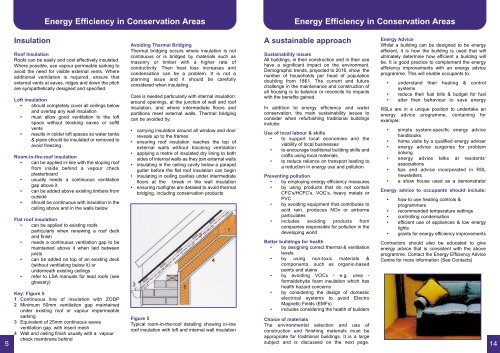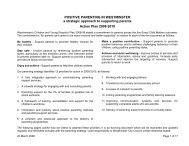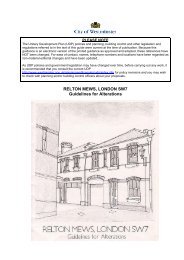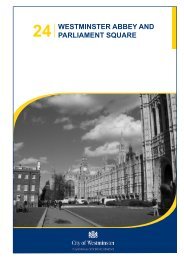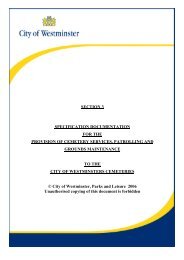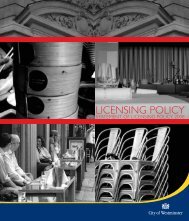Energy Efficiency in Conservation Areas - Westminster City Council
Energy Efficiency in Conservation Areas - Westminster City Council
Energy Efficiency in Conservation Areas - Westminster City Council
- No tags were found...
You also want an ePaper? Increase the reach of your titles
YUMPU automatically turns print PDFs into web optimized ePapers that Google loves.
<strong>Energy</strong> <strong>Efficiency</strong> <strong>in</strong> <strong>Conservation</strong> <strong>Areas</strong><strong>Energy</strong> <strong>Efficiency</strong> <strong>in</strong> <strong>Conservation</strong> <strong>Areas</strong>InsulationRoof InsulationRoofs can be easily and cost effectively <strong>in</strong>sulated.Where possible, use vapour permeable sark<strong>in</strong>g toavoid the need for visible external vents. Whereadditional ventilation is required, ensure thatexternal vents at eaves, ridges and down the pitchare sympathetically designed and specified.Loft <strong>in</strong>sulation• should completely cover all ceil<strong>in</strong>gs belowand overlap any wall <strong>in</strong>sulation• must allow good ventilation to the loftspace without block<strong>in</strong>g eaves or soffitvents• results <strong>in</strong> colder loft spaces so water tanks& pipes should be <strong>in</strong>sulated or removed toavoid freez<strong>in</strong>gRoom-<strong>in</strong>-the-roof <strong>in</strong>sulation• can be applied <strong>in</strong>-l<strong>in</strong>e with the slop<strong>in</strong>g rooffrom <strong>in</strong>side beh<strong>in</strong>d a vapour checkplasterboard• usually needs a cont<strong>in</strong>uous ventilationgap above it• can be added above exist<strong>in</strong>g timbers fromoutside• should be cont<strong>in</strong>uous with <strong>in</strong>sulation <strong>in</strong> theceil<strong>in</strong>g above and <strong>in</strong> the walls belowFlat roof <strong>in</strong>sulation• can be applied to exist<strong>in</strong>g roofsparticularly when renew<strong>in</strong>g a roof deckand f<strong>in</strong>ish• needs a cont<strong>in</strong>uous ventilation gap to bema<strong>in</strong>ta<strong>in</strong>ed above it when laid betweenjoists• can be added on top of an exist<strong>in</strong>g deck(without ventilat<strong>in</strong>g below it) orunderneath exist<strong>in</strong>g ceil<strong>in</strong>gs• refer to LSA manuals for lead roofs (seeglossary)Key: Figure 51 Cont<strong>in</strong>uous l<strong>in</strong>e of <strong>in</strong>sulation with ZODP2 M<strong>in</strong>imum 50mm ventilation gap ma<strong>in</strong>ta<strong>in</strong>edunder exist<strong>in</strong>g roof or vapour impermeablesark<strong>in</strong>g3 Equivalent of 25mm cont<strong>in</strong>uous eavesventilation gap, with <strong>in</strong>sect mesh4 Wall and ceil<strong>in</strong>g f<strong>in</strong>ish usually with a vapourcheck membrane beh<strong>in</strong>dAvoid<strong>in</strong>g Thermal Bridg<strong>in</strong>gThermal bridg<strong>in</strong>g occurs where <strong>in</strong>sulation is notcont<strong>in</strong>uous or is bridged by materials such asmasonry or timber with a higher rate ofconductivity. Then heat loss <strong>in</strong>creases andcondensation can be a problem. It is not aplann<strong>in</strong>g issue and it should be carefullyconsidered when <strong>in</strong>sulat<strong>in</strong>g.Care is needed particularly with <strong>in</strong>ternal <strong>in</strong>sulation:around open<strong>in</strong>gs, at the junction of wall and roof<strong>in</strong>sulation, and where <strong>in</strong>termediate floors andpartitions meet external walls. Thermal bridg<strong>in</strong>gcan be avoided by:• carry<strong>in</strong>g <strong>in</strong>sulation around all w<strong>in</strong>dow and doorreveals up to the frames• ensur<strong>in</strong>g roof <strong>in</strong>sulation reaches the top ofexternal walls without block<strong>in</strong>g ventilation• apply<strong>in</strong>g a metre of <strong>in</strong>sulated dry l<strong>in</strong><strong>in</strong>g to bothsides of <strong>in</strong>ternal walls as they jo<strong>in</strong> external walls• <strong>in</strong>sulat<strong>in</strong>g <strong>in</strong> the ceil<strong>in</strong>g cavity below a parapetgutter before the flat roof <strong>in</strong>sulation can beg<strong>in</strong>• <strong>in</strong>sulat<strong>in</strong>g <strong>in</strong> ceil<strong>in</strong>g cavities under <strong>in</strong>termediatefloors at the break <strong>in</strong> the wall <strong>in</strong>sulation• ensur<strong>in</strong>g rooflights are detailed to avoid thermalbridg<strong>in</strong>g, <strong>in</strong>clud<strong>in</strong>g conservation productsFigure 5Typical room-<strong>in</strong>-the-roof detail<strong>in</strong>g show<strong>in</strong>g <strong>in</strong>-l<strong>in</strong>eroof <strong>in</strong>sulation with loft and <strong>in</strong>ternal wall <strong>in</strong>sulationA susta<strong>in</strong>able approachSusta<strong>in</strong>ability issuesAll build<strong>in</strong>gs, <strong>in</strong> their construction and <strong>in</strong> their usehave a significant impact on the environment.Demographic trends, projected to 2016, show thenumber of households per head of populationdoubl<strong>in</strong>g from 1861. The current and futurechallenge <strong>in</strong> the ma<strong>in</strong>tenance and construction ofall hous<strong>in</strong>g is to balance or reconcile its impactswith the benefits ga<strong>in</strong>ed.In addition to energy efficiency and waterconservation, the ma<strong>in</strong> susta<strong>in</strong>ability issues toconsider when refurbish<strong>in</strong>g traditional build<strong>in</strong>gs<strong>in</strong>clude:Use of local labour & skills• to support local economies and theviability of local bus<strong>in</strong>esses• to encourage traditional build<strong>in</strong>g skills andcrafts us<strong>in</strong>g local materials• to reduce reliance on transport lead<strong>in</strong>g toa reduction <strong>in</strong> energy use and pollutionPrevent<strong>in</strong>g pollution• by employ<strong>in</strong>g energy efficiency measures• by us<strong>in</strong>g products that do not conta<strong>in</strong>CFC’s/HCFC’s, VOC’s, heavy metals orPVC• by avoid<strong>in</strong>g equipment that contributes toacid ra<strong>in</strong>, produces NOx or airborneparticulates• <strong>in</strong>cludes avoid<strong>in</strong>g products fromcompanies responsible for pollution <strong>in</strong> thedevelop<strong>in</strong>g worldBetter build<strong>in</strong>gs for health• by design<strong>in</strong>g correct thermal & ventilationlevels• by us<strong>in</strong>g non-toxic materials &components, such as organic-basedpa<strong>in</strong>ts and sta<strong>in</strong>s• by avoid<strong>in</strong>g VOCs - e.g. urea -formaldehyde foam <strong>in</strong>sulation which hashealth hazard concerns• by consider<strong>in</strong>g the design of domesticelectrical systems to avoid ElectroMagnetic Fields (EMFs)• <strong>in</strong>cludes consider<strong>in</strong>g the health of buildersChoice of materialsThe environmental selection and use ofconstruction and f<strong>in</strong>ish<strong>in</strong>g materials must beappropriate for traditional build<strong>in</strong>gs. It is a largesubject and is discussed on the next page.<strong>Energy</strong> AdviceWhilst a build<strong>in</strong>g can be designed to be energyefficient, it is how the build<strong>in</strong>g is used that willultimately determ<strong>in</strong>e how efficient a build<strong>in</strong>g willbe. It is good practice to complement the energyefficiency improvements with an energy adviceprogramme. This will enable occupants to:• understand their heat<strong>in</strong>g & controlsystems• reduce their fuel bills & budget for fuel• alter their behaviour to save energyRSLs are <strong>in</strong> a unique position to undertake anenergy advice programme, conta<strong>in</strong><strong>in</strong>g forexample:• simple system-specific energy advicehandbooks• home visits by a qualified energy adviser• energy advice surgeries for problemsolv<strong>in</strong>g• energy advice talks at residents’associations• tips and advice <strong>in</strong>corporated <strong>in</strong> RSLnewsletters• a show house used as a demonstrator<strong>Energy</strong> advice to occupants should <strong>in</strong>clude:• how to use heat<strong>in</strong>g controls &programmers• recommended temperature sett<strong>in</strong>gs• controll<strong>in</strong>g condensation• efficient use of appliances & low energylights• grants for energy efficiency improvementsContractors should also be educated to giveenergy advice that is consistent with the aboveprogramme. Contact the <strong>Energy</strong> <strong>Efficiency</strong> AdviceCentre for more <strong>in</strong>formation (See Contacts)5 14


